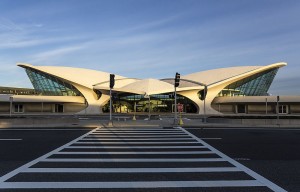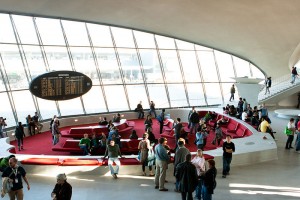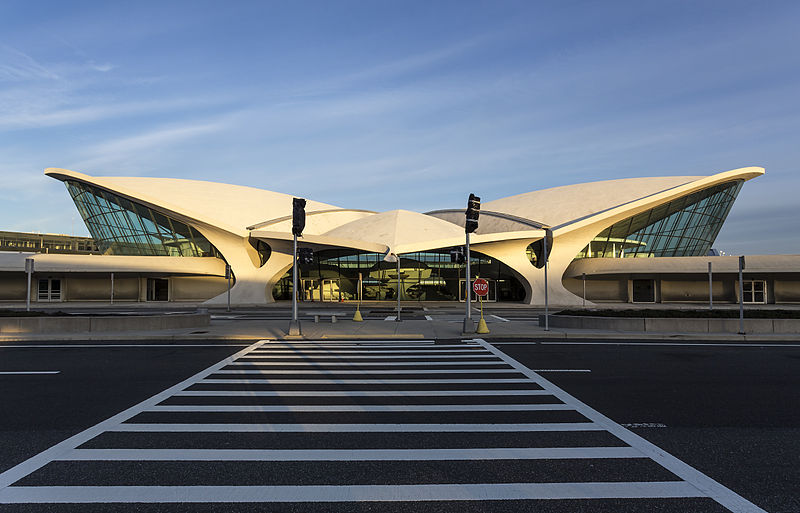The idea that architecture should support the needs of the people was not always a very intuitive thought. Previous to the expansion of world-class architecture into the private sector, innovative and modern architectural designs were limited to wealthy patrons and corporations able and willing to pay for them. Eero Saarinen’s Trans World Airlines Flight Center was an early example of architecture beginning to permeate public spaces in the form of airport terminals. The Trans World Airlines (TWA) Flight Center is a airport terminal at John F. Kennedy International Airport in Queens County, New York. It was designed by architect Eero Saarinen and opened for operation in May of 1962. 1
Eero Saarinen was a Finnish architect born on August 20, 1910 in the city of Kirkkonummi, Finland. He was born to Loja Gesellius and Eliel Saarinen. 2 After immigrating to the United States in 1923, Saarinen and his family settled in Detroit, Michigan. He later went on to study at the Yale School of Architecture and Design. 3 In the 1940’s, when the Port of New York Authority began its development of an international airport, Saarinen was tasked with designing the TWA terminal. TWA was also one of the largest airlines in America at the time. 4
The TWA Flight Center was a truly groundbreaking building for its time. Not only did it combine innovative engineering and planning, but it also incorporated many modern building materials like concrete. As seen in Figure 1, Saarinen’s TWA terminal is a structure that encased in a shell of concrete. The use of concrete effectively creates a streamlined silhouette that is extremely evocative of Saarinen’s expressionist influences. It was only through the use of concrete was Saarinen able to create such a dynamic and rigid form. The sloping roofs and curvilinear forms clearly rejected the rectilinear forms of the widespread International Style present in corporate America at the time. 5

The interior of the TWA terminal further emphasized curvilinear forms and flowing lines. There are very few right angles or strict geometric planes to be seen. Figure 2 shows the very futuristic approach to design that Saarinen implemented. Many of the circulation spaces were sunken into the ground or curvilinear in form. Flight panels were also very dramatically shaped to look like futuristic screens that also followed the circular and curvilinear aesthetic.

It is clear that Saarinen’s design of the TWA Flight Center was very innovative for its time. Not only does it incorporate modern materials like concrete but it also implemented a very radical design aesthetic for its time. It was one of the first progressive pieces of modern architecture to be used in a public space for civilian use. Although the TWA terminal is no longer in operation due to it limited capacity for current air travel demands, it has since been named an important historic and architectural landmark and is undergoing restoration. 6
– JX
Figure 1: TWA Flight Center at the John F. Kennedy International Airport (1962), Queens County, NY. Eero Saarinen. Photographer: Acroterion, Wikimedia Commons. Link. (Accessed November 21, 2015)
Figure 2: TWA Flight Center at the John F. Kennedy International Airport (1962), Queens County, NY. Eero Saarinen. Photographer: Brett Weinstein, Wikimedia Commons. Link. (Accessed November 21, 2015)
Notes:
- “TWA Flight Center, JFK International Airport, Queens County.” Preservation Success Story. Accessed November 12, 2015. ↩
- Michael A. Capps. “Architect Eero Saarinen.” National Parks Service. Accessed November 19, 2015. ↩
- Ibid. ↩
- Ibid. ↩
- “Trans World Airlines Flight Center, John F. Kennedy International Airport, Jamaica Bay, Queens (subdivision), Queens County, NY.” Historic American Buildings Survey (Library of Congress). Accessed November 19, 2015. ↩
- Ibid. ↩
